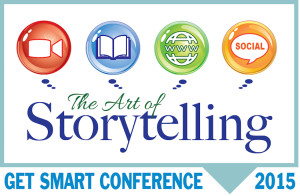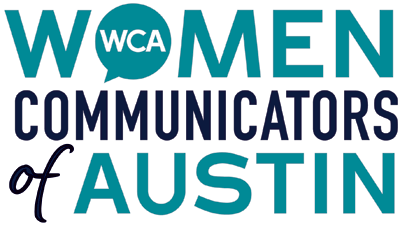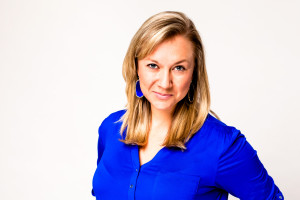Written by Katie McKee.
In this digital age, visual storytelling is one of the most compelling ways to make your story stand out, but how do you do it? At the Get Smart: The Art of Storytelling this Friday, November 6, conference-goers who attend “Video and Animation: If a picture is worth a thousand words, is a video or animation a better way to tell your story?” will learn how to create engaging videos and animation projects, regardless of budget or experience level.
We asked the session’s three panelists – Ashley Jennings of CF Studios, Ellie Brett Scarborough of Media Bombshell and Lana McGilvray of Blast PR – as well as moderator LisaBeth “LB” Thomas of LBTJ a few questions about adding visual components, themselves and what you can expect to learn at the session. This is what they had to say:
How do you use video and/or animation in your professional work?
AJ: I started out in news. I was with the CBS affiliate in DC then left local news for network in New York. For a few years I was a field producer for ABC News and later helped launch Al Jazeera America, serving as a producer on their daytime shows. My journey with news production eventually left me longing to tell stories for businesses and people. After making my way back to Austin, I started my own production/ photography firm and helped launch a studio inside Capital Factory, called CF Studios. At CF Studios we focus on helping companies not just figure out what their story is, but how to tell that story in the form of video or animation. We truly believe video is the most forefront marketing tool out there, so let’s do it right.
ES: How don’t I? Video is both one of the main ways that I get clients and one of the main things that I help clients with. I’ve gotten more clients through my homepage video, people who’ve simply watched the video and wanted to work with me having never met me, than who’ve read my newsletter. Often, clients will come to needing help with their media. Some clients come to me because they want to finally make a homepage worthy video or they want to put a all their intellectual property into a final product, but of all the areas I work with people on spreading their message and their work, video is hands down the one that is growing the most within my clientele.
LM: At Blast PR, we often incorporate video and animation into the campaigns we help our clients produce and execute, ranging from featuring compelling, new short-form videos from the likes of Carl’s Jr. in conjunction with their last Super Bowl campaign produced by one of our clients, as well as the recent use of illustrated emojis to support a large scale traditional and digital media campaign to publicize Pope Francis’ recent visit to the U.S. in the way most likely to attract attention and engage target audiences.

Ellie Brett Scarborough
LB: I’ve been in video production since my days at KVUE in the early 90s. I was the Creative Services Director and as I watched commercials being taped, I’d always think of ways that the spots could be more effective or engaging. I then left KVUE and became President of the Ranch Studio here in Austin where we shot corporate videos, commercials, TV shows and movies. It was a blast and I loved seeing how everything came together. I literally can see the final product in my head and then work backwards with timeline, crew, editing, etc. to make it happen — I love it. I then had a great opportunity to be the producer of Real Life with Gerald Mann, and it was awesome; we had a live show every week, several specials. It definitely kept me on my toes. I later started my own company. We did some video work for GSD&M and at their suggestion we became an agency as well as a video production company.
What’s the biggest video mistake professionals/companies make?
AJ: Not identifying their target audience first — it’s CRUCIAL for companies and their leaders to sit down and really know “who” they’re trying to tell their story to. From that, we can dissect “why” it matters and “how” to build it into a powerful marketing tool.
ES: I see three major mistakes. The first one is that people try to say too much in a video. It’s like they feel like they have to say everything at once, but they don’t understand is that this is just a way to show people who you are, not every ounce of knowledge you have. The second one is that they don’t truly understand who their audience is and what they want to hear so that it’s not resonating with them. The third is that they don’t have the skill sets that allow them to showcase their personality and expertise on camera. For example, someone may be great at networking or spectacular on stage, but it doesn’t mean that they can transfer that on camera. It’s something they have to learn.

Lana McGilvray
LM: Not hiring professionals. Although there are actually great examples of selfie videos that have been put to great use or attracted attention, video and sound quality are important. In general, I do not think this challenge is limited to video. When you want the best, it’s usually best to work with the best or use the best tools or means if you have the talent in-house.
LB: Trying to tell the WHOLE story. Our attention span is limited so the more precise and to the point you can be, the better. Also, using “talking heads” without b-roll, graphics or images. It is important to keep the video interesting and engaging. The more you can use different elements it keeps the viewer’s attention.
What’s the best storytelling advice you’ve ever received?
AJ: A former colleague of mine in New York once said, “Sit down and tell the story as if you’re on the front porch having tea with grandma.” I’ve carried those words with me ever since and say it to anyone before I get behind a camera to interview them, “Relax. We’re just sittin’ on the front porch, telling this story to grandma.” It keeps the content organic and easy to comprehend. If you’re not telling it in a way where grandma can follow along, neither can your audience.
ES: The biggest way that people will connect with you when you’re sharing something is when you allow yourself to be real and not just show the shiny pretty parts, but tell the whole story. The best advice I’ve ever gotten would be from my dad who’s been in TV longer than I’ve been alive. Beware of finding what you’re looking for. If you go into a situation thinking you know the story before you get there, you’re closing yourself off from finding out the real story.
LM: Be authentic.
LB: Early on in my career I watched an amazing producer edit a video. He was meticulous about the video and audio cutting to the same beat. For example: when the voiceover (VO) finishes making a point and has moved on to the next, the video should cut to the new point — not linger for a few frames. He showed me both with hitting on the same beat and without. I couldn’t believe how that one simple point could make all the difference. It is something I use everyday.
Can you give attendees a sneak peek of what to expect in your session at Get Smart?
 AJ: We’ll break down all walls of traditional storytelling and really dive into what it means to make sharp, original content that doesn’t just deliver your message to a specific audience, but also reaches more of those audience members than you ever thought possible. I’ll also talk a little bit about media strategy and give tips on booking press coverage.
AJ: We’ll break down all walls of traditional storytelling and really dive into what it means to make sharp, original content that doesn’t just deliver your message to a specific audience, but also reaches more of those audience members than you ever thought possible. I’ll also talk a little bit about media strategy and give tips on booking press coverage.
ES: I’ll talk about the power of language and how to make your words matter so that every second you’re on screen you make the most of it. I believe that we all want to moved and inspired and video is an incredibly powerful tool to move and inspire without ever having met them.
LM: While I am not trying to “can” my talk, lately I’ve been very attracted to the subject of why audio-visual storytelling is more important than ever in an ADD kind of world. To that point, I’m hardly immune and have found myself following in the footprints of my eight year old — time shifting my consumption, seeking and spending a lot more time with shorter segments on mobile devices.
LB: I’m excited to be moderating the panel for this and I’m looking forward to learning from my amazing colleagues as well!
Get Smart 2015 is only a few days away – don’t miss out on a great opportunity to hear from 18 Austin communications experts and their insider’s guide for how to tell your story perfectly, every time in any medium. Register now!
- Announcing Our 2016-2017 Board of Directors - May 31, 2016
- Freelance Corner: Making Impressions, Copyright FAQs and Nixing Procrastination - May 25, 2016
- Austin’s Best Kept Secrets: Swimming Holes - May 24, 2016


